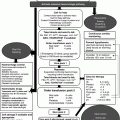Chapter 2 Stephen F. Hawkins1, Jecko Thachil2 and Quentin A. Hill3 1 Department of Haematology, Royal Liverpool University Hospital, Liverpool, UK 2 Department of Haematology, Central Manchester University Hospitals NHS Foundation Trust, Manchester, UK 3 Department of Haematology, Leeds Teaching Hospitals NHS Trust, Leeds, UK Leukopenia is defined as a total white blood count (WBC) or leukocyte count below the lower limit of the reference range for the laboratory in question (e.g. <3.5 × 109/L). Leukopenia on admission to intensive care occurs in approximately 7% of admissions and is associated with increased mortality [1]. It can be a result of a reduction in any of the major subtypes of WBC (neutrophils, lymphocytes, monocytes, eosinophils or basophils), but most frequently neutrophils and/or lymphocytes, which contribute most to the total WBC count. The differential diagnosis of neutropenia and lymphopenia can be seen in Table 2.1. Table 2.1 Differential diagnosis of leukopenia. The severity of neutropenia may be divided into mild (1.5 − 2 × 109/L), moderate (0.6 − 1.4 × 109/L) or severe (≤0.5 × 109/L). Persistent and severe neutropenia is more likely to be clinically significant and lead to complications. The pathogenesis of neutropenia can include decreased production from the bone marrow, increased destruction in the blood circulation, increased margination to the vascular endothelium, neutrophil aggregation and splenic pooling. In the ICU setting, neutropenia is usually secondary, most commonly to drugs or infection. A primary haematological cause such as leukaemia or another malignancy will rarely develop in a patient who arrived in the ICU with a normal neutrophil count. A drug-induced cause for neutropenia can easily be overlooked due to the multiple agents the patients may receive. A temporal relationship between the commencement of any drug and the development of neutropenia is usually the only clue and may not be considered. A sudden drop in the count can also suggest drug-induced neutropenia, and often, the neutropenia resolves soon after the discontinuation of the drug.
Leukopenia
Sepsis
Infection
Viral (e.g. HIV)
Bacterial (e.g. TB)
Post-infective
Drug-induced (e.g. phenytoin, cotrimoxazole)
B12 and/or folate deficiency
Immunological (e.g. SLE)
Bone marrow failure (e.g. haematological malignancies)
Neutropenia
Stay updated, free articles. Join our Telegram channel

Full access? Get Clinical Tree






